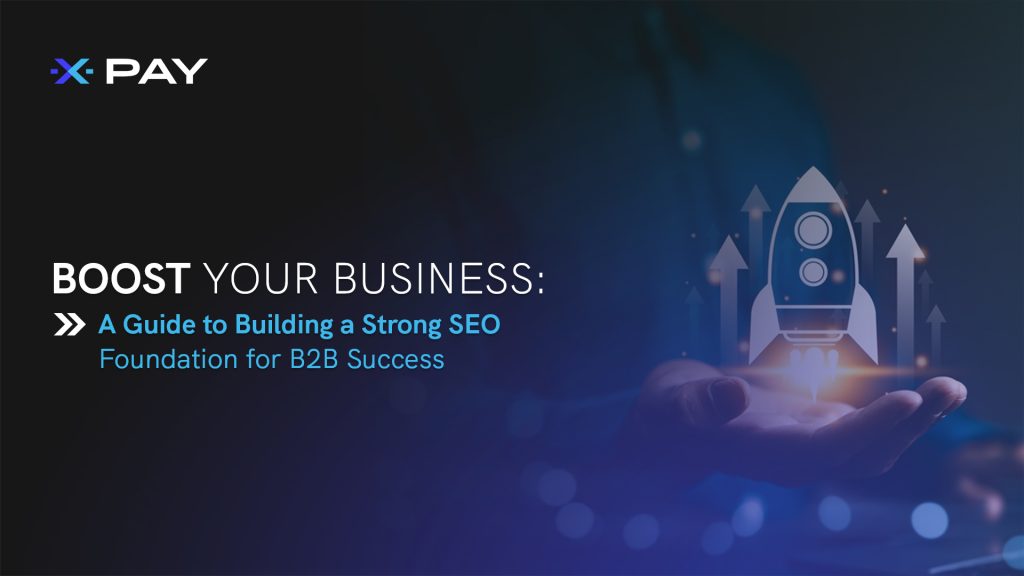Boost Your Business: A Guide to Building a Strong SEO Foundation for B2B Success
Learn from XPay’s step-by-step proven journey to create an impactful SEO strategy that attracts, engages, and converts.
Standing out in the digital world requires a blend of visibility, relevance, and a deep understanding of your customer. At XPay, we grew our online presence and drove conversions with SEO alone, building a strategy grounded in research, analytics, and continuous optimization.
This guide shares the step-by-step process we followed to help B2B industries attract the right audience and convert visitors into long-term customers.
Step 1: Define and Optimize for Your Ideal Customer Profile MOZ, Semrush, Ahrefs
What XPay Did: We started by understanding our Ideal Customer Profile (ICP) to ensure our content would meet the needs of businesses looking for secure, scalable payment solutions.
Your ICP serves as the backbone of your marketing and SEO efforts, helping you craft content that truly resonates. At XPay, we utilized data from Google Analytics and insights from our existing client base to develop a focused ICP, then tailored our content to these key profiles.
How to Build and Use ICP for SEO Success:
-
Analyze Current Customers: Use Google Analytics to segment traffic by behavior, interests, and demographics. We identified that many of our users were SMEs focused on security, payment speed, and customer satisfaction.
-
Gather Data-Driven Insights: Tools like M1 ICP allow for precise customer segmentation. XPay used this to understand the common challenges and needs of our audience.
-
Refine Regularly: An ICP is not static. Revisiting it periodically based on engagement data helps ensure your content stays relevant. XPay’s focus on high-security fintech content arose from regular data reviews showing this was a priority for our clients.
Step 2: Lay SEO Foundations Early, From Website Development Onward
What XPay Did: When we redeveloped XPay’s website, SEO wasn’t an afterthought; it was part of the blueprint. Prioritizing technical SEO from the start allowed us to create a seamless user experience that enhances search engine visibility.
SEO should be part of your website’s foundation, not an add-on. Elements like a clear site structure, fast loading times, and mobile responsiveness improve both user experience and SEO.
Key Technical SEO Actions for Building a Strong Base:
-
SEO-Optimized Site Structure: Use a clear hierarchy that aligns with your ICP’s needs. At XPay, we structured our content around user intent, grouping information by category (e.g., payment security, API integrations).
-
Speed Optimization: Google PageSpeed Insights helped us address slow-loading elements, keeping our site efficient and user-friendly.
-
Schema Markup: Implement schema to help search engines understand the content. This increased our click-through rate by making our listings stand out with rich snippets, like FAQs and reviews.
Step 3: Fine-Tune On-Page SEO for Higher Discoverability
What XPay Did: On-page SEO is critical for connecting with the right audience. By focusing on strategic keywords, meta descriptions, and internal linking, XPay made sure our content was well-positioned for search engines and aligned with our ICP’s search behavior.
Practical Steps for Effective On-Page SEO:
-
Keyword-Driven Titles and Descriptions: Using tools like Semrush, we identified high-intent keywords such as “best payment gateway for SMEs” and integrated these into our titles and meta descriptions. This helped attract the right audience at critical touchpoints.
-
Internal Linking Strategy: We created connections between blog posts, service pages, and case studies to improve the user journey. For example, blogs discussing fintech security linked directly to our service pages, creating a seamless path for users.
-
Content Refresh Strategy: XPay periodically revisits high-performing content to update it with new insights and maintain relevance. Refreshing older posts has helped us rank well for continuously evolving topics like “online payment security.”
Step 4: Create High-Quality, User-Centric Content That Engages and Converts
What XPay Did: We centered our content around real-world challenges faced by our audience. For instance, articles on topics like “How to Enhance Payment Security” addressed direct pain points, making XPay a trusted source in fintech.
Quality content is about adding value and solving problems. XPay’s approach to content involves a mix of blogs, videos, and infographics, catering to diverse user preferences and consistently positioning us as an industry expert.
How to Build Effective Content for SEO and Conversions:
-
Identify Pain Points Through Analytics: Google Analytics and user surveys informed us of our audience’s challenges, such as security in online transactions. We built a content calendar around these insights, creating blog posts that directly address these issues.
-
Diversify Content Formats: XPay uses blogs, videos, and infographics to engage users in multiple ways. Video content, for instance, has proven effective in boosting engagement, particularly around complex topics like payment processing and security.
-
A/B Test Content Styles: Regular testing helps determine which content resonates most. At XPay, we A/B tested long-form guides versus shorter, FAQ-style posts and found that guides performed better for topics needing depth, while FAQs attracted high engagement on commonly searched issues.
Step 5: Improve Website User Experience (UX) to Increase Retention and Conversions
User experience directly impacts SEO performance and visitor satisfaction. When your site is fast, easy to navigate, and responsive, it not only encourages users to explore further but also signals to search engines that your content is valuable. At XPay, we took specific steps to enhance our UX based on analytics and feedback.
What XPay Did: By continuously refining our UX (Which will never stop), we made it easier for users to navigate the site, stay engaged, and ultimately convert. These UX enhancements reduced our bounce rate and increased time on site, key factors that improved both our SEO ranking and overall conversions. By building a user-friendly website that’s also technically optimized, we are creating a solid foundation for user engagement and search engine visibility.
Actionable Steps to Improve UX for SEO and Conversions:
-
Website Speed Optimization:
Slow load times can drive visitors away. Using tools like Google PageSpeed Insights, we pinpointed areas where XPay’s site could improve, such as compressing images, minimizing JavaScript, and leveraging faster hosting solutions. As a result, our page load times decreased significantly, reducing bounce rates and improving user satisfaction.
-
Designing for Mobile Accessibility:
With a large percentage of our audience browsing on mobile, XPay prioritized a responsive design from the start. Mobile traffic has been increasing consistently, and a seamless experience on all devices has led to a notable boost in mobile engagement metrics.
-
Simplified Navigation and Clear CTAs:
We restructured XPay’s website navigation to make it as intuitive as possible, ensuring users can find key pages (like Solutions, FAQs, Developer’s Hub, and Contact Forms) within just a few clicks. Additionally, clear and compelling CTAs were strategically placed throughout the site, encouraging users to take the next step, whether that’s learning more about our services or reaching out to our team. This focus on clarity and accessibility increased both page views and conversions.
-
Using Google Analytics to Identify UX Bottlenecks:
We regularly monitor bounce rates, session duration, and conversion paths on Google Analytics to identify any UX issues. For instance, analytics revealed that certain pages had high exit rates, prompting us to optimize content layout, add links to related resources, and streamline CTAs. By continuously fine-tuning our site based on data insights, we kept our users’ experience smooth and engaging.
-
Continuous A/B Testing of UX Elements:
To ensure we were meeting user expectations, XPay conducted A/B tests on various UX components, from button colors and CTA placement to different menu structures. Testing and comparing user interactions on these changes allowed us to make informed decisions on what worked best, driving more conversions over time.
Step 6: Leverage Social Media and Email Marketing to Support SEO
What XPay Did: We extended our content reach through social media and email marketing, boosting engagement and attracting new visitors to our site. Consistent sharing on platforms like LinkedIn has driven increased traffic and search engine signals.
SEO is not isolated from other marketing efforts. Integrating social media and email marketing can drive additional organic traffic to your website, enhancing your SEO.
Steps to Integrate Social and Email Marketing with SEO:
-
Share Content Across Channels: Each time XPay published a new blog or guide, we shared it on LinkedIn, and via email newsletters, creating more entry points for our audience.
-
Engage with Followers: Our team actively responds to questions and comments on social media, fostering a sense of community and authority in fintech. This engagement encourages shares and can drive more backlinks to our content.
-
Use Email to Drive Repeat Traffic: Regular newsletters featuring high-value content directed our subscribers to XPay’s blog. This strategy resulted in steady traffic from repeat visitors, enhancing SEO through user engagement metrics.
Looking Ahead: Start point to more helpful blogs to help your business
This blog is the first in a series where XPay shares its approach to content and SEO. Stay tuned for more blogs that will add to your strategy and help you SEO.
Conclusion: By following these foundational steps in SEO, you can attract targeted traffic and improve conversion rates, just as XPay did. Remember, SEO is a continuous process of refinement—each step you take builds on the previous one, creating a strong, scalable strategy that drives real business growth.






